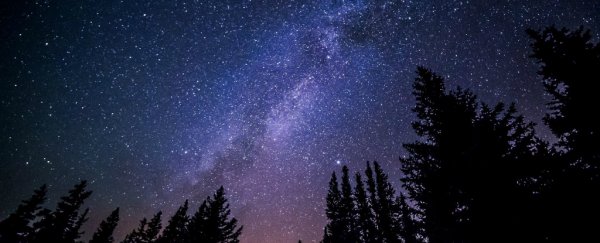It's been a rough 2016 on Earth, so I wanted to share (just some of) my reasons why I think we should celebrate New Years as 2017 is looking incredibly exciting.
Everything from meteor showers and eclipses to epic space missions and more, 2017 will be worth looking up for and forward too.
1. Quadrantids Meteor Shower
Kick off the New Year with a meteor shower on the night of 3/4 January thanks to the debris tail from asteroid 2003 EH1. Earth will plunge through dust and tiny pieces of rubble that then burn up in our atmosphere as shooting stars.
These will appear to originate from the North, in the constellation of the Big Dipper meaning this is best enjoyed by Northern Hemisphere observers.
The Moon is only partially illuminated meaning it won't outshine many of the expected 100 or more shooting stars every hour.
2. Juno explores Jupiter
Exploring one of the Solar System's most dangerous places is ambitious enough but to do so 37 times seems insane, yet that's exactly what NASA's Juno mission is undertaking this year.
It entered orbit around Jupiter on the 4 July 2016 and at the close of the year had already started to reveal what lies beneath the clouds that make up the Gas Giant.
As it threads underneath the dangerous radiation belts around Jupiter, skimming just 5,000 km from the cloud tops, we will have unrivalled closeups of the chemical composition and structure of the planet.
Thanks to Junocam those closeups will be as beautiful to view as they are valuable for science.
3. SpaceX test launch
In 2016 SpaceX made history by landing their Falcon 9 first stage rocket after it had launched satellites into space.
This came to an end when a rocket exploded on the launchpad, a worrying failure for a system that was nearing human crewed flight tests to ferry astronauts to the International Space Station.
Along with other proponents of human exploration and settlement of space I will be nervously watching the resumption of launches in early 2017 to see if the 'anomaly' has been fixed.
If SpaceX can reuse its rockets rather than discard them in the same was as aircraft are refuel upon reaching a destination airports it could usher in a new era of cheaper space travel.
The good times in 2016 when SpaceX landed on a barge in the ocean seemingly effortlessly. The resumption of test launches in 2017 will be eagerly awaited with crossed-fingers the world over.
4. Great American Eclipse
This Solar Eclipse will be on August 21st and totality (the complete eclipsing of the Sun by the Moon) will be visible in a narrow band stretching across the continental US.
In anticipation of the event, NASA has created a super accurate Moon model for the eclipse path.
The craggy, cratered surface of the Moon results in stray sun-rays reaching Earth so that the the shadow region (as seen from space) is not the normally modelled oval.
Check NASA for the best observing times in your location.
5. TESS to launch
Thanks to the Kepler Spacecraft we know of thousands of alien worlds, and in 2017 NASA will launch the successor mission TESS (Transiting Exoplanet Survey Satellite).
Targeting 200,000 bright stars across the sky TESS hopes to find 500 Earth-sized worlds that briefly pass between us and dim the starlight.
Crucially these alien worlds will be much closer to us than the planets spotted by Kepler meaning Earth-based telescopes can potentially measure the contents of their atmosphere and see if the conditions are right for life as we know it.
6. China's Mission to the Moon
China will continue to advance its rapidly developing space capability with a sample return mission from the Moon.
The uncrewed Chang'e 5 will launch in 2017 with the goal of landing and returning 2 kg of lunar regolith to Earth.
If successful this effort will mark the first time that material has been returned from our neighbour since Gene Cernan and Apollo 17 left the Moon for the last time 45 years ago.
7. Grand Finale around Saturn
On the 15th September, the Cassini spacecraft around Saturn will end its almost two decade long mission by burning up into the atmosphere of the gas giant.
It will mark the end of an astoundingly valuable scientific mission and one that reached new highs at the end of 2016 when it embarked on a Grand Finale tour of the innermost rings of Saturn.
A region never before explored, and with over 20 dives between ring and planetary cloud-tops, we will learn about how these rings formed as well as uncover some of the hidden planet's contents.
The fiery end will ensure that hardy microbes on the spacecraft can't contaminate the potentially habitable moons of Enceladus and Titan, Cassini's final and ultimate contribution to space science.
In 2017, we won't have to rely on computer generated animations of the swansong dive around Saturn by Cassini but will have the real thing as part of its Grand Finale.
8. Geminids Meteor Shower
End the year as it began with a meteor shower from asteroid 3200 Phaethon, which reaches its peak on the early hours of December 14 (visible anytime after midnight of the 13th December).
This can be viewed by most of the world in the constellation of the Gemini (Twins). Even better with a New Moon just days away it will be dark enough to ensure almost all of the 120 shooting stars each hour will be visible.
There's many more missions and space events, but if you get to experience even some of these events then maybe 2017 really will have been worth celebrating.
Alan Duffy, Research Fellow, Swinburne University of Technology
This article was originally published by The Conversation. Read the original article.
![]()
